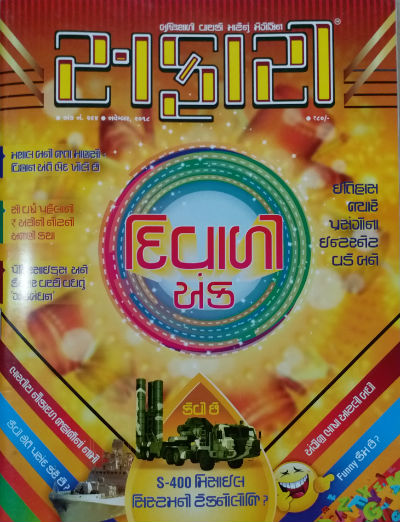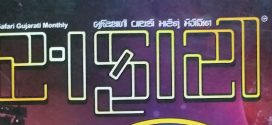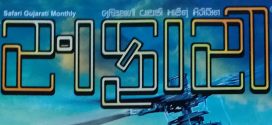November 2018 issue of Safari, a Gujarati knowledge Magazine is released quite on time and we are happy to have it and enjoy reading the same. On behalf of our team let me share my unbiased views and Reviews for the same with you. But before we go ahead, let me wish everyone a very Happy Diwali and a Prosperous New Year.
Here is the cover page of the same.

Safari Magazine | Gujarati Edition | November 2018 Issue | Cover Page
I strongly believe in not judging a magazine by its cover page. However, I also believe that the first impression made by a cover page or poster of any media lasts longer and it influences the reading and purchase decisions. So, the importance of a cover page cannot be ruled out. So, let us talk a little about the cover page of this issue of Safari.
It is a Diwali special issue an thus is almost double in size and price both. ut, when quality writing weaved with factual information, it is definitely worth going for. The issue is priced at INR 80. The bright colors on the cover page makes it interesting. The background is having the shades of brown to yellow and it reflects the mood of celebration. Most of the interesting articles in the issue are mentioned on the cover page. The war-related items are looking like toys, but or otherwise, the cover page is quite impressive.
While it is comparatively less read part of any magazine, or for that matter any newspaper too, “The Editorial” is one of the most important segments of the respective media and I strongly recommend you to never give it a miss.
The editorial gives an opportunity to the editor of the issue to share his/her thoughts with the reader about anything including but not limited to the content of the issue, current happenings or something similar.
In this segment, Nagendra Vijay shares his thoughts about the decreasing importance of regional languages in the blind run for English. Of course, English is a fantastic language and no one can deny the importance of the reading the same, but at the same time, your mother tongue or native language represents the flavor of the region which no other language can replace. Mr. Nagendra Vijay mentions the contribution of the scholars like Father Vallés and Sheldon Pollock in the field of languages of India (that is Bharat).
He then refers the contribution of two remarkable scholars:
And yes, he also mentions, how getting the primary education in mother tongue helped him in coming up books like “Asaan Angreji” which provides an easy and effective way to learn English. Definitely a thought-provoking and thoughtful article. It reminded me about one FaceBook post I recently came across which was intended to tell something like: “In the country where you need to press 2 – to choose Hindi as your preferred language (when calling a support number for almost any service)…”. It is hard to digest reality. Unless and until we are proud of the good things we possess, we tend to lose it.
Under this segment, every month there is an incredible aspect of India (usually from the history of the country) is explored. This time, it explores the contribution of Bhatias through the sea voyages. They are considered as descents of Kshatriya clan and eventually earned expertise in making world class (or rather say best in the world) ships and played a vital role in expanding Indian business to the outside world.
Rather than talking about it much I would recommend you to read this small (2 pages only) article, as later you can link with another article from the issue.
English, considered one of the most important languages in the world has many aspects. Do you know that it was not the mother-tongue of the famous Queen Victoria? Do you know that some of the remarkable quotes by William Shakespeare are grammatically wrong? How many times do you feel that why there are some silent letters remain in words like psychology, hour, and many others?
A dissection of the language in a funny way is a must read article from this issue. It takes you through some of the unknown and/or lesser-known historical information and brings you the information you will enjoy.
In other words, we can say that English language is used here as a tool for an informative and interesting journey. This 6 pages long article Ravindra Acharya should be read by understanding the aspects it is written in, to enjoy thoroughly.
The word Internet reflects (an almost unending) chain of links between various things. And, if you study history from the exploration aspects with interest then you will surely find a link between the historical incidents. Basically, it often takes you to a place in time where a small incident has started a “chain reaction” which was least expected from it!
Nagendra Vijay’s article about an incident happened at the Surat port (Gujarat, India) and how it leads to the incidents in Karachi port (then part of India), Mumbai, World War(s) and eventually to Mumbai port of partitioned India? The article refers to many historical figures from India and other countries!
It is a 12 pages long article which elaborates the history in quite an interesting manner. The article is studded with many picture and illustrations and is not to be missed.
From the mythological tale of Bhasmasur to some modern-day incidents, “Spontaneous human combustion” is mostly linked with paranormal or supernatural activities.
In fact, you can find an article on the topic on Wikipedia also, here is a quick link:
It is quite different than self-immolation. As self-immolation is intended or initiated knowingly while Spontaneous human combustion is something unexpected. Most of the cases are still unsolved and conclusion the immediate investigation agency of the respective incident reached on is not so satisfying in most of the cases.
A simple question that if a human body consists of around 70% of water (which is a fact) then how can it be burnt so suddenly without having much of the extra burning material? Even a significant amount of wood, Ghee and other such ingredients are required for the Hindu ritual of deceased and it took a significant amount of time too.
B. M. Purohit came up with an article which lists out such inexplainable incidents and makes us think on various theories. The conclusion given by a scientist which is the most logical is mentioned at the end. These incidents are appeared in various previous issues of safari and will give deja-vu feelings to regular readers of the magazine. And that is obvious because such incidents made scientists doing brainstorming since around 400 years. The article also brings in some freshness by added latest information. Of course, the article is written in an interesting manner and has some historical photographs and illustrations to go with.
There was a time when smaller bugs and other species were the reason of damaging corps. And, various kind of mosquitoes, viruses and other such enemies used to bring in dangerous (even life claiming in many cases) fevers and diseases.
With the advancement of science and technology why the situation is not so changed?
The increasing usage of pesticides in the farms is proving dangerous to human health as well. Based on the instinct of the survival of the fittest, the small species (which are changing generations in a short period) are getting stronger to fight these pesticides and the dose needs to be increased periodically. The humans, however, cannot cope with the adverse effects the crops grown this way brings to them!
There is a must-read article in this issue which talks about it. A recommended read for sure.
An article by Ravindra Acharya talks about 2.5 rupees note and Indian history is an interesting read. This article explores historical incident from the year 1918-2018. A well researched and nicely authored article.
Nagendra Vijay’s article about the evergreen question(s), how did the universe come to existence? and Will (or how will) it going to end? Definitely, an article not to be missed.
B. M. Purohit’s article about the latest warships which are being built for Indian Naval Services is interesting. In addition to inform about the tradition of naming various armed forces vehicles and other important stuff, this article also informs readers that around 41 new ships are being built! And, the citizens are welcome to suggest the names for them, of course, based on the rules and guidelines for the same. Don’t miss this article.
There are regular segments like Factfinder (Q/A), Mind games etc brings in some fantastic information for the readers.
In short, if you are interested in getting factual information and genuine knowledge, this magazine issue is definitely worth going for.
Summary:
Definitely, worth your money and especially the time you spend to read it. Don’t give it a miss. The only thing I can mention as a drawback of this issue is, it is available in a regional language (Gujarati) and thus its reach is limited. This is definitely one of the best resource you can have to enjoy Diwali and welcome the New Year 🙂
Do let us know your views about this article via comments below, we like to read you. And yes, do not forget to share this article with your friends who you think are interested in quality reading. Also subscribe to our newsletter, to get notified periodically about the articles we publish.
 ThinkerViews – Views And Reviews Personal views and reviews for books, magazines, tv serials, movies, websites, technical stuff and more.
ThinkerViews – Views And Reviews Personal views and reviews for books, magazines, tv serials, movies, websites, technical stuff and more.



